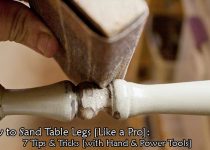How to Sand Plywood to Get a Smooth Finish
The main purpose of sanding is to dispel the marks of the workhouse and give it a smooth finish. These marks usually occur because of the workhouse machines. Also, there some marks as well such as gouges and dents. These marks decrease the charm. That’s why it is very important to know how to sand plywood as the most effective way of removing these marks is sanding.
Plywood is made of two or more flattened panels of timber veneer. It doesn’t look like wood when it stays in its own way. But, when you color the plywood apply polyurethane, it looks like real wood. First, you have to sand the plywood so that, it becomes smooth.
There are many types of sandpaper such as 180 grit, 200 grit, 220 grit which will make the plywood smoother. Also, you can use a different kind of sandpapers to get the smoothest finish. The higher the grit is, the finer the sandpaper will be.
There is no permanent rule of sanding as it is a personal choice. People sand differently with a number of passes and pressure. But, there are some methods which will make your sanding affordable and good at the same time.
Now, look at the easy steps of sanding plywood below. But first, you need to know about the things that you are gonna need for sanding.

Table of Contents:=>
- 8 Steps to Sand Plywood Quickly to get a Smooth Finish:
- Step 1: Find The Perfect Sandpaper
- Step 2: Remove The Dust
- Step 3: Sanding with 180 Grit Sandpaper
- Step 4: Sanding with 200 Grit Sandpaper
- Step 5: Sanding with 220 Grit Sandpaper
- Step 6: Remove The Sanding Dust
- Step 7: Hand Sanding
- Uses of Sander [Power Tools]:
- Sanding Edges of Plywood:
- “Detail Sander” for Edge Sanding
- How Much to Sand
Things You Need for Sanding
- 180 grit Sandpaper [Check on Amazon]
- 200 grit Sandpaper
- 220 grit Sandpaper
- Orbital Sander [Check on Amazon]
- Detail Sander [Check on Amazon]
- Hand Sander [Check on Amazon]
- face mask
- hand gloves
8 Steps to Sand Plywood Quickly to get a Smooth Finish:
Step 1: Find The Perfect Sandpaper

The ideal sand is 180 grit. Usually, we don’t need sand which is finer than this. Sand more subtle than 180 grit is not much beneficial.
After a few coats, water-based ending and film building endings, such as lacquer, varnish, shellac, usually raise their own periphery. It doesn’t decrease the outlook. The sense of the finish is it’s own and it won’t create any impact. So, it doesn’t matter how fine you sand the plywood.
If you want less stain paint, when you remove the extra, on your plywood then you can sand finer than 180 grit. If that’s not what you want, then there is no need of going surpassed 180 grit.
Step 2: Remove The Dust
Before you start sanding your plywood make sure that it is clean. Dirt and dust may ruin your sanding process. So, it is necessary to wipe away the dirt and dust before you start sanding your desirable plywood.
Step 3: Sanding with 180 Grit Sandpaper
For sanding the plywood, you need 180-grit sandpaper. You have to stroke it in the same direction of the grain over the plywood. Don’t do it more than 3 to 4 times. If you do so, the presence of a number of grooves in the surface is seen, also, layers can be found peeled up from the plywood ends. This hitch Evokes any faults in the wood.
Step 4: Sanding with 200 Grit Sandpaper
After sanding the plywood using 180 grit sandpaper, you to sand it again. But, this time you have to use 200 grit sandpaper. Follow this process for three to four times including the surface. 180 grit sandpaper creates some imperfections while grinding. This finer 200 grit sandpaper sleeks the imperfect lines.
Step 5: Sanding with 220 Grit Sandpaper
Now, make two passes over the periphery and abrade your plywood with sandpaper which is 220 grit. It gives a superfluous smooth finishing to your plywood. This is the final sanding. After this, you can apply colour or you can just finish it.
Step 6: Remove The Sanding Dust

You have to remove the sanding dust before you go to the next step. For cleaning the dust You can use a vacuum, it gives you the cleanest finishing. You can also use compressed air. For instance, spray booth. It will remove the sanding dust. If you don’t have these tools then you can also use a clean cloth.
You don’t have to remove the dust out of the pore. Remove it as much as you can. You won’t be able to see anything after painting. Just clean them, so that you don’t pick up any dirt or dust while wiping.
Step 7: Hand Sanding

There is the last step after sanding with different types of the sander and this is hand sanding. We all know that power sanding is better for heavy work. But power sanders usually leave some small scratches that can ruin your finish.
That’s why a final hand sanding is very important as it produces a finer finish. Also, hand sanding is better for smoothing corners, edges, curves and other small spots as it is more flexible.
Things You Need for Hand Sanding
- Flexible sanding pad
- Sandpaper backers
- Heavy-weight sandpaper or sanding block
- Scrap cutoff
Uses of Sander [Power Tools]:

If you want to make the surface of plywood smooth quickly then “wood sander” is the best option for you. It smoothens the periphery of wooden thing. Also, there are some electric sanders such as “orbital sander“.
You need different sandpapers for different sanding techniques. You have to remove the paint first by using hand tools or sanding machines to finish the work, and make it smooth.
Sanding Edges of Plywood:

Sanding makes the surface smoother and shiny. But when it comes to the edges, it might not smooth the edges as it smoothes the surface. It’s a little difficult to sand the edges.
You can use an oscillating drum sander for sanding the edges. It will retain the edge square and smooth. You can keep your plywood strait if you use block and sandpaper together.
There is another way of sanding your plywood edge. You have to build an L shaped jig for this. Hold the long side down on the MDF and attach sandpaper on the small side. It will help you to keep the edge square.
Also, you can cut the plywood slightly. By using a blade, you can get a smooth edge faster. It will save a lot of sanding.
“Detail Sander” for Edge Sanding

There are many sanding tools out there for edge sanding which make your work easier than before. Also, they give you better possession and amazing work.
You can use this “detail sander” and other tools for sanding the edges as well as the surface and other compact areas. It is one of the best sanders which is used for sanding edges. You will find it with a triangular sanding pad.
This “detail Sander” is similar to “orbital Sander”. But, “detail sander” is way better than others as it gives a great finish to tight corners.
But, sometimes, you may not find the exact sander in the market. In this case, there are some other effective sanders for edge sanding. Such as,
- Mouse sander for tight spots
- Drum sander
- Drill drum sander for circle sanding
How Much to Sand
It is very important to know when you have to stop sanding. Most of the people can’t decide when to stop and overdo sanding. You don’t need to do sanding after you have removed all the flaws and scratches and for this, you have to know when it is the perfect time to stop so that you can move forward. And this is the most challenging about sanding.
Though this depends on the experience but there are two methods that can help you to understand this. First, remove the dust and look at the plywood at a low angle which will reflect the light. For instance, look from a light fixture or a window. Second, wet the plywood and look from various angles.
You can use denatured alcohol or mineral spirit for making the plywood wet. If you are planning to give it a water-based finish then try to avoid mineral spirits. When it comes to denatured alcohol, you have to sand it again to get a smooth finish as denatured alcohol raise the grain a bit.
Now you already know the process of sanding plywood. All you have to do is go through the basics again to know it from the core.
Also, let us know if you find these steps easy and affordable or not. Share your thoughts in the comment box.
Last Updated on April 24, 2021 by Rogers Weber
[As an Amazon Associate I earn from qualifying purchases.]


